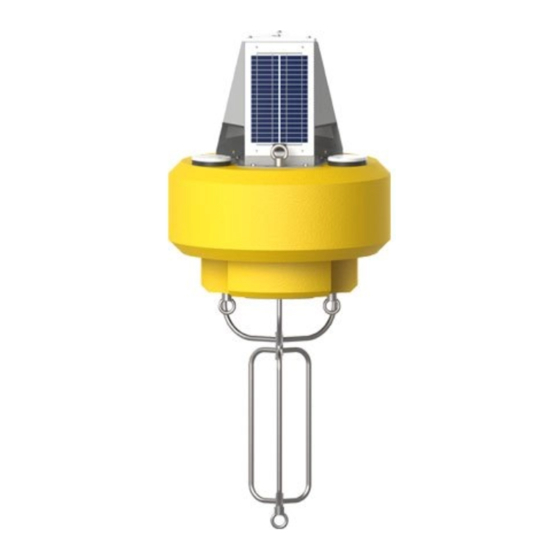Advertisement
Quick Links
CB-450 Data Buoy – Quick Start Guide
The NexSens CB-450 Data Buoy is designed for deployment in lakes, rivers,
coastal waters, harbors, estuaries and other freshwater or marine
environments. The floating platform supports both topside and subsurface
environmental monitoring sensors including weather stations, wave sensors,
thermistor strings, multi-parameter sondes, and other monitoring
instruments.
What's Included:
(1) Buoy hull with data well
•
(3) 10W Solar panels (mounted to tower)
•
(1) Data well lid
•
(3) Top-side lifting eyes
•
(3) Bottom-side mooring eyes
•
(1) Instrument cage
•
Advertisement

Summary of Contents for NexSens CB-450 Data Buoy
- Page 1 CB-450 Data Buoy – Quick Start Guide The NexSens CB-450 Data Buoy is designed for deployment in lakes, rivers, coastal waters, harbors, estuaries and other freshwater or marine environments. The floating platform supports both topside and subsurface environmental monitoring sensors including weather stations, wave sensors, thermistor strings, multi-parameter sondes, and other monitoring instruments.
- Page 2 CB-450 Data Buoy – Accessories The CB-450 Data Buoy is a platform and can be accessorized with any of the following components or users can configure the buoy with alternatives. Common Accessories CB-A05-1 Battery harness with integrated solar regulator & (1) 28 A-Hr battery CB-A05-2 Battery harness with integrated solar regulator &...
- Page 3 CB-450 Step-by-Step Assembly Attach the cage to the buoy frame: Attach the cage to buoy frame using the ¾” bolt, lock washer and castle nut. Tighten firmly with 1-1/8” wrenches or large crescent wrenches. Be sure to flatten the lock washer and lineup the hole in the bolt with the notches in the castle nut.
- Page 4 CB-450 Step-by-Step Assembly Understanding the data well with NexSens data loggers The data well is a waterproof canister located in the center of the buoy hull. Batteries are secured at the bottom and a data logger is mounted to the underside of the lid. The data well...
- Page 5 CB-450 Step-by-Step Assembly Understanding the NexSens data logger ports Ports include: • (5) sensor input ports P0A - 12V switch power, shared RS-232 with port P0B, SDI-12, RS485 P0B - 12V switch power, shared RS-232 with port P0A, SDI-12, RS485...
- Page 6 CB-450 Step-by-Step Assembly Understanding sensor ports For compatibility sensors must have either factory installed UW connectors, be connected using a UW Plug and Flying Lead cable or be wired using the UW Field Wireable Plug Recommendation: Invest in factory connectorization of all sensors for a long-term robust and waterproof connection UW to Flying Lead Cable Lid receptacle connector pinout...
- Page 7 CB-450 Step-by-Step Assembly Connecting power Three solar panels provide charging energy by sunlight exposure while the buoy is free to move and rotate in any direction. Connect the 6-pin solar panel plug into the COM/SOLAR port on the data well lid and the solar panels will provide power to the charge regulator, which will keep the internal batteries charged.
- Page 8 CB-450 Pre-deployment Testing Perform system tests Important: Never deploy the buoy without first preforming all system tests. Check that the battery voltage is near 12VDC by placing the leads of a voltmeter on pins 4 (red) and 7 (black) of a P0A or POB. Note the voltage and the proceed to checking the solar charging.
-
Page 9: Safety First
CB-450 Deployment SAFETY FIRST Warning: It highly recommended that buoys are installed by professionals with training in marine safety. Anchors, chains, heavy gear and boat clutter during deployment is unsafe. Care must be taken during deployment to maintain a clean and safe environment. Use of proper equipment (work boat, lifting rig, gloves, safety footwear, etc.) is essential to safely deploy any buoy system. - Page 10 CB-450 Deployment Installing sacrificial anodes Important: To avoid excessive corrosion on buoy frames and cages always use sacrificial anodes and isolate dissimilar metals in saltwater applications. Install the CB-Series Buoy Zinc Anode to both the cage and buoy frame. The anode will slowly corrode away. Inspect and replace as needed.
- Page 11 CB-450 Deployment Understanding ballast weight and stability Important: To prevent overturning and ensure stability, additional ballast weight may be needed. As configured at the factory, the center of gravity of the buoy is near the water surface. A single point mooring line and chain, connected to the eye at the bottom of the cage is typically enough weight to ensure stability.
- Page 12 CB-450 data buoys. To develop an effective mooring strategy, a variety of application-specific criteria (water level fluctuations, currents and wave action, debris loads, etc.) must be thoroughly reviewed prior to deployment. NexSens does not endorse any particular mooring strategy for any specific application.
- Page 13 CB-450 data buoys. To develop an effective mooring strategy, a variety of application-specific criteria (water level fluctuations, currents and wave action, debris loads, etc.) must be thoroughly reviewed prior to deployment. NexSens does not endorse any particular mooring strategy for any specific application.




Need help?
Do you have a question about the CB-450 Data Buoy and is the answer not in the manual?
Questions and answers